
Our disaster, their wonderland
May 19th, 2017
I went birding at Mud Lake on Wednesday the 10th. It was like no visit to Mud Lake ever before, and probably none hence. (For those of you in Ottawa, you maybe heard in the news about "flooding in Britannia"? Yeah. Britannia is where Mud Lake is.) I felt quite confident heading down the trail with a pair of knee-high rubber boots on. But even thus equipped I was unable to complete the loop.
The pond (connected with the swollen Ottawa River) had simply taken over. For large swathes of the trail, there was no trail. There were ducks paddling and fish swimming where there had once been a trail. And the Rusties, oh my god, the Rusties. Rusty Blackbirds, as I mentioned in my last post, are a species of icterids who love foraging on flooded ground. The rich brown coloration that gives them their name is only seen in fall and winter. By this time of year, females are charcoal and males are glossy black, with striking pale eyes, like miniature short-tailed grackles. In good light they show a steel-blue sheen. They are largely birds of the boreal forest and muskeg, breeding north of us, and their population is in decline. Normally if I see a few of them in a year I'm happy.
Mud Lake was dripping with Rusty Blackbirds, far, far more than I'd ever heard or seen. To them it was a wonderland. Anywhere there was water where there shouldn't be, there they were, strutting along the margins of the flood or perching over it, and filling the air with their odd, stuttery, gurgling songs. As I splashed my way down the "trail" I could see the flocks retreating before me--but now and then a straggler granted me a photo op. I was in heaven seeing, hearing and photographing so much of a bird that is usually elusive to me.
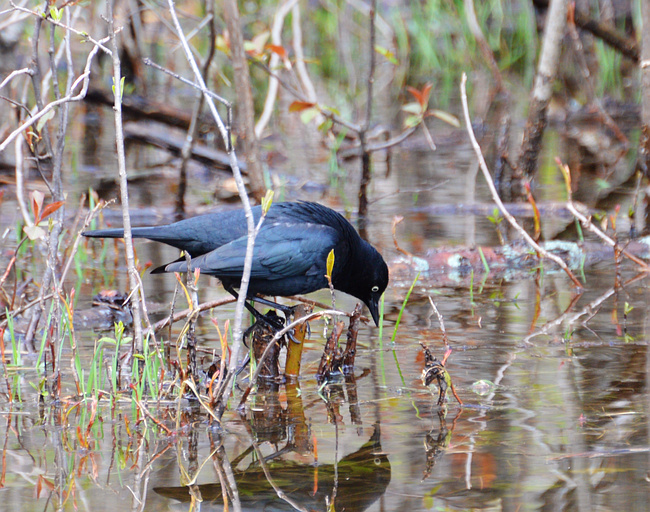
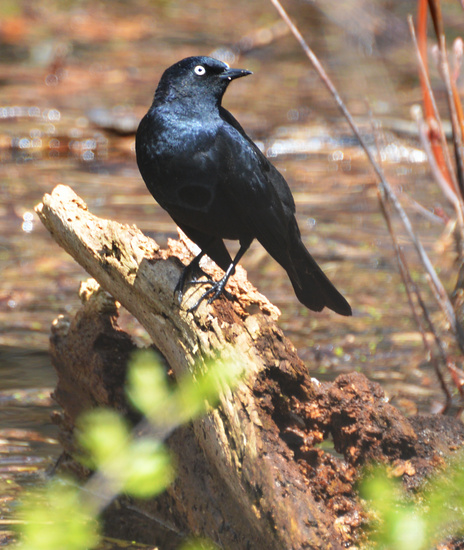

That was a trail once.

The west entrance to the ridge.
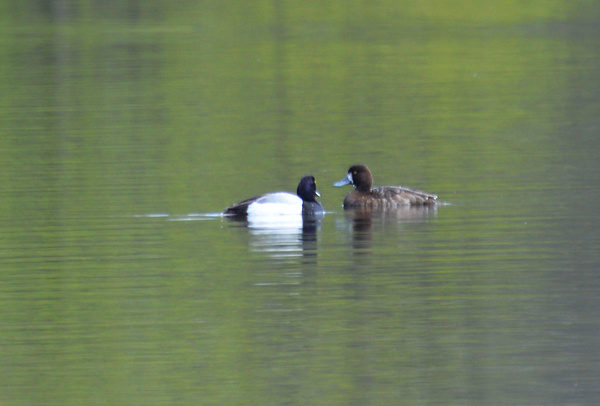
Another sign that we're not in Kansas anymore: a mated pair of Greater Scaup on Mud Lake. These are diving ducks who prefer fairly deep water. They show up mainly on large rivers (like the Ottawa) in migration, and breed on large lakes--actual lakes, which "Mud Lake" isn't. But in its flooded state, it must have looked like decent habitat to them!
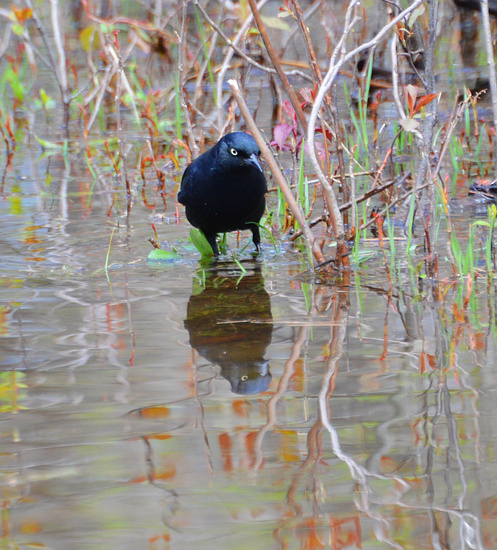

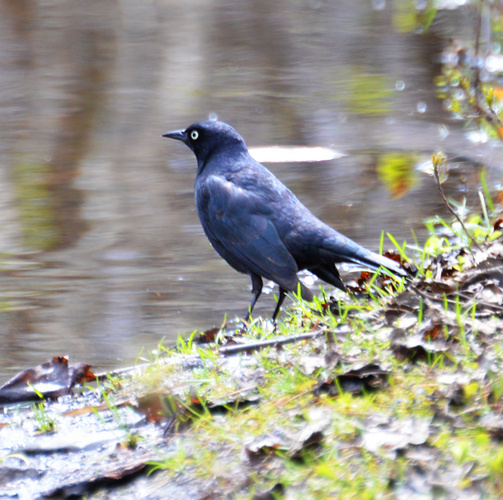
It was a slow day for migrant warblers, unsurprisingly, since our weather had only just rebounded from freezing cold and snow. There were a few Yellow-Rumped Warblers, including this male peeking out from the brush---
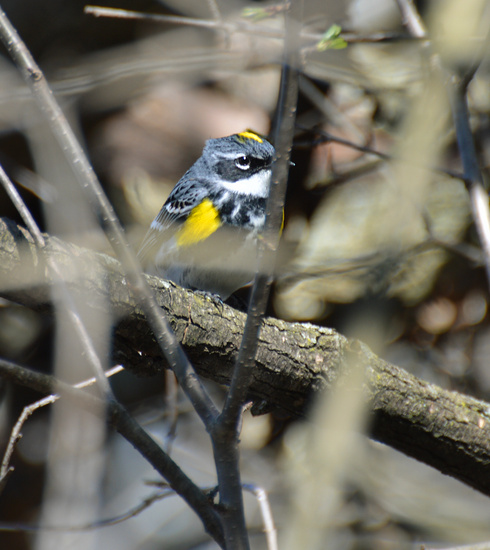
--a few Palm Warblers, and at least one Northern Parula in the tall spruces east of the ridge, who attracted lots of photographers. This is a close up on a very small bird, about 4 and a half inches long.
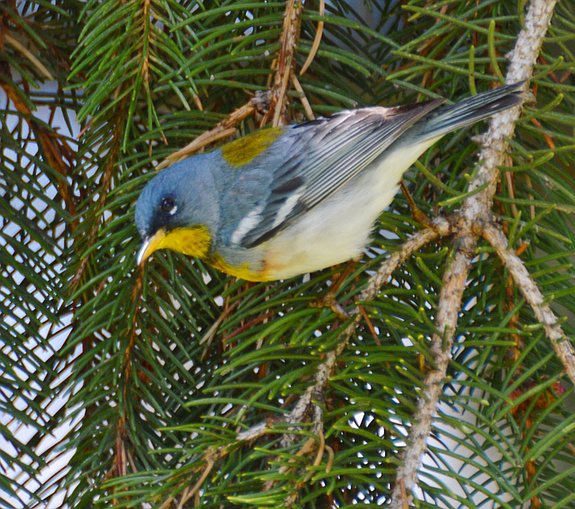

Trout Lilies bloomed in profusion in the woods, a sign of spring--
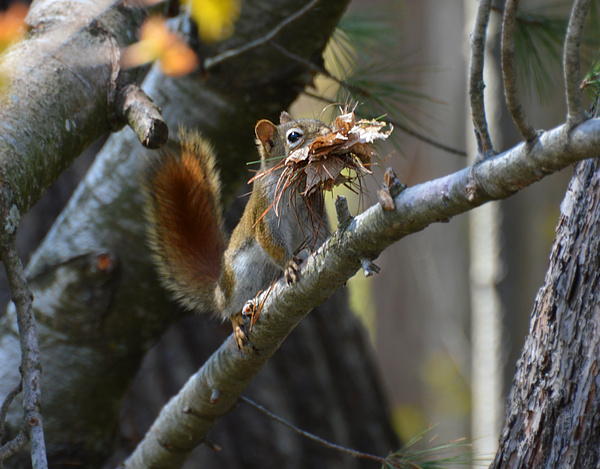
--and another sign of spring, this Red Squirrel busily gathering up material for a nest.
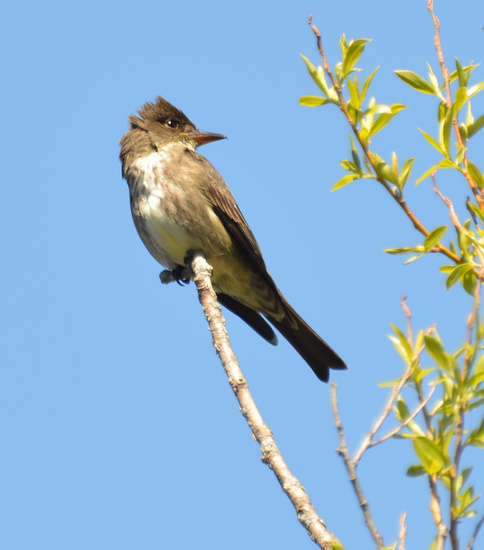
And lastly we have this fellow, an Olive-Sided Flycatcher. It may look drab, but it was the star of the day: my first sighting of this species in Ottawa! Its big head, robust beak and overall size, as well as its habit of flycatching from the most conspicuous perch available, all set it apart from its much more common lookalike, the Eastern Wood-Pewee. Olive-Sided Flycatchers nest north and west of us, only appearing in Ottawa in migration. They are fond of burned-over areas. In fact my lifer was gotten at the site of a large forest fire in the Okanagan valley.
Next up, Point Pelee. Spoiler alert: warbler photography was once again a bust, but I do have a few things to share.
May 19th, 2017
I went birding at Mud Lake on Wednesday the 10th. It was like no visit to Mud Lake ever before, and probably none hence. (For those of you in Ottawa, you maybe heard in the news about "flooding in Britannia"? Yeah. Britannia is where Mud Lake is.) I felt quite confident heading down the trail with a pair of knee-high rubber boots on. But even thus equipped I was unable to complete the loop.
The pond (connected with the swollen Ottawa River) had simply taken over. For large swathes of the trail, there was no trail. There were ducks paddling and fish swimming where there had once been a trail. And the Rusties, oh my god, the Rusties. Rusty Blackbirds, as I mentioned in my last post, are a species of icterids who love foraging on flooded ground. The rich brown coloration that gives them their name is only seen in fall and winter. By this time of year, females are charcoal and males are glossy black, with striking pale eyes, like miniature short-tailed grackles. In good light they show a steel-blue sheen. They are largely birds of the boreal forest and muskeg, breeding north of us, and their population is in decline. Normally if I see a few of them in a year I'm happy.
Mud Lake was dripping with Rusty Blackbirds, far, far more than I'd ever heard or seen. To them it was a wonderland. Anywhere there was water where there shouldn't be, there they were, strutting along the margins of the flood or perching over it, and filling the air with their odd, stuttery, gurgling songs. As I splashed my way down the "trail" I could see the flocks retreating before me--but now and then a straggler granted me a photo op. I was in heaven seeing, hearing and photographing so much of a bird that is usually elusive to me.



That was a trail once.

The west entrance to the ridge.

Another sign that we're not in Kansas anymore: a mated pair of Greater Scaup on Mud Lake. These are diving ducks who prefer fairly deep water. They show up mainly on large rivers (like the Ottawa) in migration, and breed on large lakes--actual lakes, which "Mud Lake" isn't. But in its flooded state, it must have looked like decent habitat to them!



It was a slow day for migrant warblers, unsurprisingly, since our weather had only just rebounded from freezing cold and snow. There were a few Yellow-Rumped Warblers, including this male peeking out from the brush---

--a few Palm Warblers, and at least one Northern Parula in the tall spruces east of the ridge, who attracted lots of photographers. This is a close up on a very small bird, about 4 and a half inches long.


Trout Lilies bloomed in profusion in the woods, a sign of spring--

--and another sign of spring, this Red Squirrel busily gathering up material for a nest.

And lastly we have this fellow, an Olive-Sided Flycatcher. It may look drab, but it was the star of the day: my first sighting of this species in Ottawa! Its big head, robust beak and overall size, as well as its habit of flycatching from the most conspicuous perch available, all set it apart from its much more common lookalike, the Eastern Wood-Pewee. Olive-Sided Flycatchers nest north and west of us, only appearing in Ottawa in migration. They are fond of burned-over areas. In fact my lifer was gotten at the site of a large forest fire in the Okanagan valley.
Next up, Point Pelee. Spoiler alert: warbler photography was once again a bust, but I do have a few things to share.
| ← | → |

mustangsallie
May 20th, 2017 at 1:23 pm
So.......My favorite hiking grounds are now history for me. I am truly heart-broken!
Suzanne
May 20th, 2017 at 1:37 pm
No no--the flood has already receded by now, Mud Lake is back to normal. It was just a temporary situation due to heavy, sustained rains and a swollen Ottawa River. The same depth of water could also be found in peoples' yards in some places during the worst of this--in fact some folks in low-lying areas living close to the Ottawa River actually lost their homes.
That's why I call it a disaster--not a disaster for Mud Lake though, just a temporary weirdness!
Suzanne
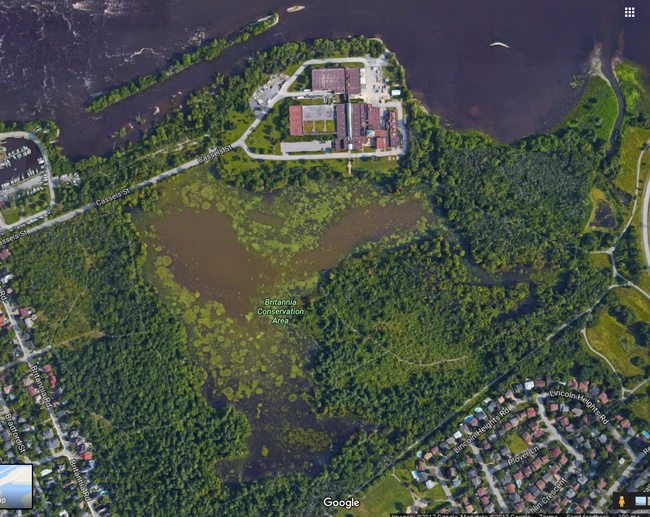
May 20th, 2017 at 2:18 pm
Here's something you might find interesting, an aerial view of Mud Lake (aka Britannia Conservation Area) taken from Google Maps:
That's the Ottawa River up top, and the group of buildings between the river and Mud Lake is the water filtration plant. It may look like Mud Lake and the river are separated, but they're not, at least not in spring. In spring those woods to the southeast of the plant are very swampy woods, with standing water linking the river and the pond. During spring thaw you typically can't complete the loop around Mud Lake because of that spot, unless you have tall waterproof boots or are willing to get your feet wet or maybe balance precariously atop a beaver dam :-)
This spring, of course, was much much worse than usual. Instead of the trail flooding in just that one spot, it flooded all over the place.
mustangsallie
May 20th, 2017 at 8:20 pm
Whew!! Good to know. I want to be able to walk there without boots and not have to deal with a lot of mud either.
Mike
May 22nd, 2017 at 9:31 am
A silver lining to the flooding, I guess, but I still hope we don't get more of that anytime soon!
I really like pictures 2, 6, 11, 12, and 13; I think the Trout Lilies may be my favorite of the set.